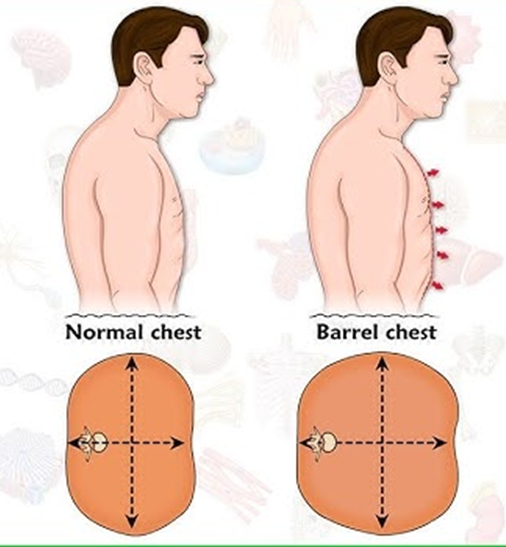While examining a client, the nurse observes the client's chest to be barrel-shaped. The nurse would interpret this as indicating which of the following?

Pigeon Chest
Pneumonia
Funnel Chest
COPD
The Correct Answer is D
Choice a reason:
Pigeon Chest, or pectus carinatum, is a condition where the breastbone is pushed outward, and the chest appears to protrude. It is not typically associated with a barrel-shaped chest, which is characterized by a rounded and bulging appearance.
Choice b reason:
Pneumonia is an infection that inflames the air sacs in one or both lungs, which may fill with fluid or pus. While it can cause chest expansion, it does not lead to a barrel-shaped chest. The barrel-shaped chest is more indicative of a chronic condition rather than an acute infection like pneumonia.
Choice c reason:
Funnel Chest, or pectus excavatum, is a condition where the breastbone is sunken into the chest. Unlike a barrel-shaped chest, funnel chest gives the chest a depressed appearance.
Choice d reason:
COPD, or Chronic Obstructive Pulmonary Disease, is commonly associated with a barrel-shaped chest. This shape results from the chronic hyperinflation of the lungs due to obstructive lung disease, which causes the rib cage to remain expanded.
Nursing Test Bank
Naxlex Comprehensive Predictor Exams
Related Questions
Correct Answer is C
Explanation
Choice A Reason:
The facial nerve, or cranial nerve VII, is responsible for the taste sensation in the anterior two-thirds of the tongue, not the posterior third. It carries taste sensations from the front part of the tongue via the chorda tympani branch.
Choice B Reason:
The abducens nerve, or cranial nerve VI, has no role in taste sensation. It is primarily involved in controlling the lateral rectus muscle of the eye, which abducts the eye.
Choice C Reason:
The glossopharyngeal nerve, or cranial nerve IX, provides special sensory innervation for taste to the posterior third of the tongue. This enables the sensation of various tastes like salty, sweet, sour, and bitter in this region.
Choice D Reason:
The hypoglossal nerve, or cranial nerve XII, is responsible for motor control of the tongue muscles but does not provide sensory innervation for taste.
Correct Answer is C
Explanation
Choice a reason:
The inability of the eye to look outward, known as lateral rectus palsy, is associated with cranial nerve VI, the abducens nerve, not the oculomotor nerve. The oculomotor nerve does not control the lateral rectus muscle which governs this movement.
Choice b reason:
Myopia, or nearsightedness, is a refractive error of the eye where distant objects appear blurry while close objects can be seen clearly. It is not related to oculomotor nerve paralysis, which affects eye movements and pupil response, not the shape of the eyeball or the refractive properties of the lens.
Choice c reason:
Ptosis, or drooping of the upper eyelid, and an absence of pupillary constriction are classic signs of oculomotor nerve paralysis. The oculomotor nerve controls most of the eye's movements, including lifting the eyelid via the levator palpebrae superioris muscle and constricting the pupil through the circular muscles of the iris.
Choice d reason:
Normal eye movement would not be expected in a patient with oculomotor nerve paralysis. This nerve controls the majority of the eye's movements, so paralysis would lead to abnormal eye movement, such as the inability to move the eye upward, downward, or inward.
Whether you are a student looking to ace your exams or a practicing nurse seeking to enhance your expertise , our nursing education contents will empower you with the confidence and competence to make a difference in the lives of patients and become a respected leader in the healthcare field.
Visit Naxlex, invest in your future and unlock endless possibilities with our unparalleled nursing education contents today
Report Wrong Answer on the Current Question
Do you disagree with the answer? If yes, what is your expected answer? Explain.
Kindly be descriptive with the issue you are facing.
